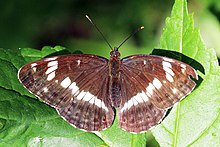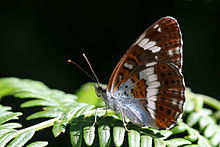Limenitis camilla
- This article is on the old world species; for information on the North American White Admiral, see Limenitis arthemis.
| White Admiral | |
|---|---|

| |

| |
| both, Oaken Wood, Surrey | |
| Scientific classification | |
| Kingdom: | |
| Phylum: | |
| Class: | |
| Order: | |
| Family: | |
| Genus: | |
| Species: | L. camilla
|
| Binomial name | |
| Limenitis camilla (Linnaeus, 1764)
| |
| Subspecies | |
| |
| Synonyms | |
| |
The (Eurasian) White Admiral (Limenitis camilla) is a butterfly of the Nymphalidae family. They are found in woodland throughout southern Britain and much of Europe and Asia, extending as far east as Japan.
Adult white admirals have black wings with white bands. The contrasting colours help to break up the outline of the wing, camouflaging it from predators. They have a wing span of approximately 60–65 mm and have a distinctive, elegant flight consisting of short periods of wing beats, followed by long glides.
The white admiral feeds on bramble blossom and honeydew and the female will lay its eggs singly on wisps of honeysuckle growing in dense woodland. The caterpillars are green with red-brown hairs and are camouflaged on a leaf, by a mixture of their own dropping and silk. As autumn approaches it will form a tent-like structure made of leaf tissue known as a hibernaculum which it then secures to the stem with silk before hibernating. The caterpillar will then awaken the following spring and after a brief spell of feeding will moult, revealing a spiny green skin. It will then pupate during the summer, forming a green and gold chrysalis. After approximately two weeks the adult will emerge.
Larvae feed on Lonicera (L. japonica, L. xylosteum, L. tatarica, L. maackii, L. gibbiflora) and Weigela horstensis.[1]
Subspecies
Listed alphabetically.[1]
- L. c. camilla – Caucasus, Transcaucasia
- L. c. japonica Ménétriés, 1857 – Amur, Ussuri
-
Dorsal side
-
Ventral Side
-
Young caterpillar
-
Caterpillar
-
Illustration from John Curtis's British Entomology Volume 5
References
- ^ a b Limenitis camilla, funet.fi






